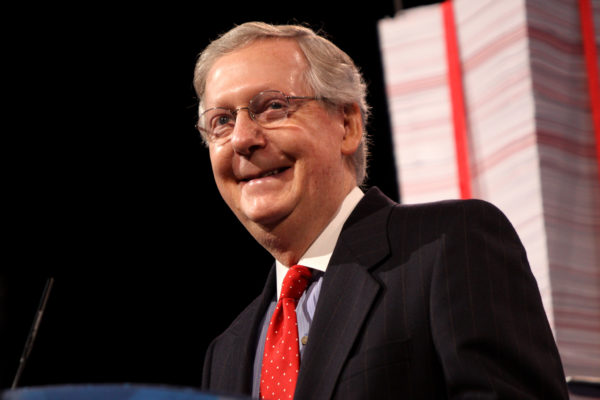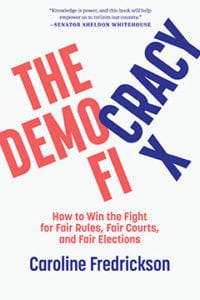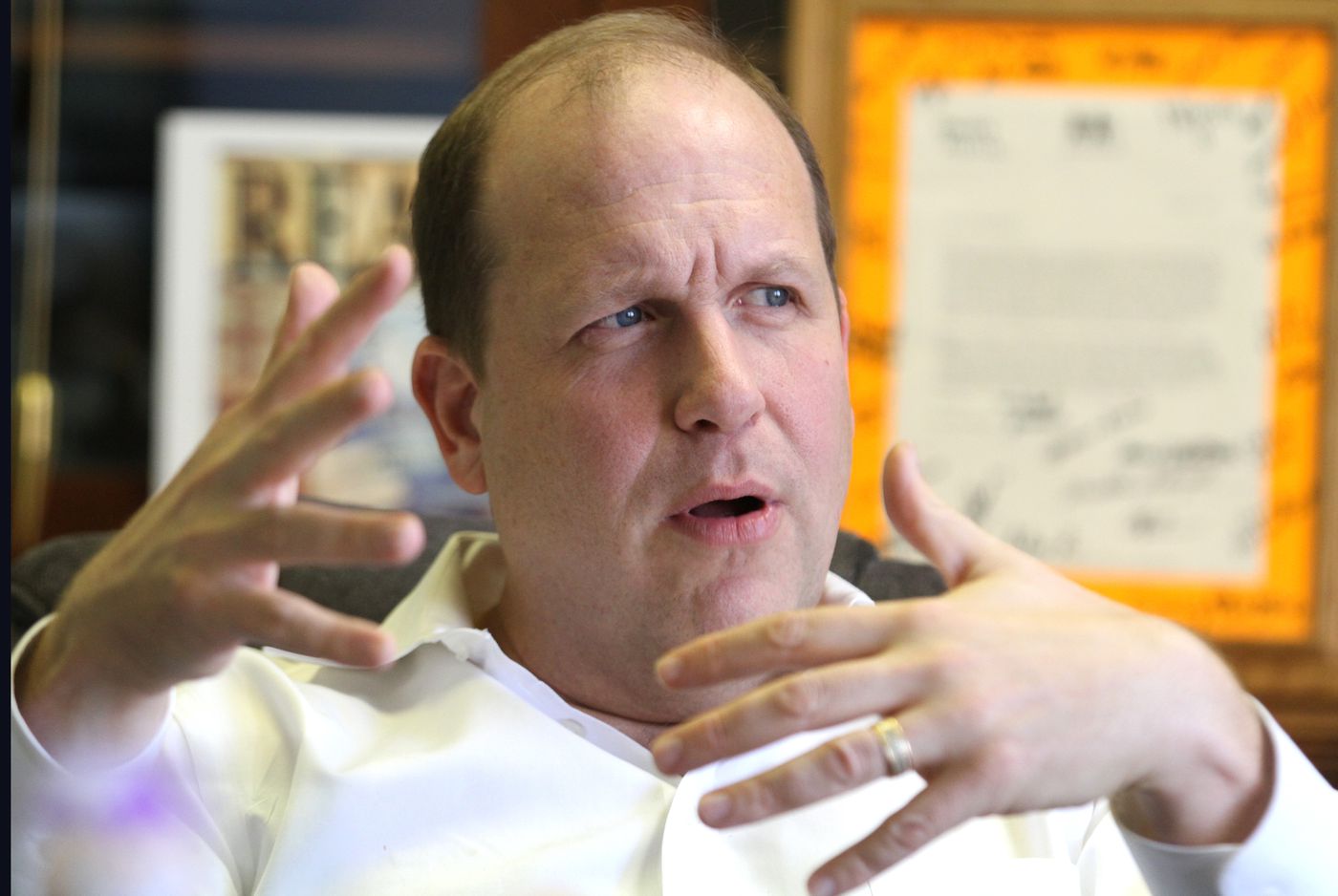 Gage Skidmore/flickr
Gage Skidmore/flickrAccording to Gallup polling, more Americans identify as Democrats than Republicans. On average, roughly 29 percent of Americans identify as Democrats, 27 percent as Republicans, and 41 percent as independent. It’s close, but the edge is enough that one would expect our legislatures, courts, and governorships to reflect that advantage.

The Democracy Fix
How to Win the Fight for Fair Rules, Fair Courts, and Fair Elections by Caroline Fredrickson, The New Press, 256 pp.
They don’t. Despite being the less popular party, Republicans have controlled the majority of our state legislatures and governorships for the past decade. In twenty-two states, Republicans control both branches of government, compared with only sixteen for Democrats. A majority of Supreme Court justices have also been appointed by Republican presidents. And Donald Trump won the presidency despite losing to Hillary Clinton by almost three million votes. How have Republicans pulled this off?
In The Democracy Fix, Caroline Fredrickson, president of the American Constitution Society (and a regular writer for this magazine), gives a detailed and often demoralizing account of how Republicans seized political power that vastly exceeds the public support for their ideas. Tracing the origin story back to Lewis Powell’s memo—in which the then corporate attorney who would later become a Supreme Court justice outlined a plan for conservative dominance of public policymaking—Fredrickson shows how the GOP used gerrymandering, voter suppression, dubious scholarship, and dangerous media outlets to rig the system in their favor. And although she offers a plan for Democrats to fight back, it feels like Republicans have already won a game Democrats didn’t realize they were playing.
Cynical gamesmanship—like Mitch McConnell denying a confirmation hearing to President Obama’s Supreme Court nominee Merrick Garland—has allowed Republicans to gain control of our democratic institutions in unseemly ways. Fredrickson’s book weaves a fascinating tapestry that shows the different pieces that fit together as part of Powell’s devious master plan.
In his 1971 memo, Powell created an ingenious road map for pro-business interests to gain control of legislatures, the courts, and the media. The plan, as Fredrickson notes, was to “fund a broad array of institutions that would exert control over the instrumentalities of power.” And they did: Wealthy conservatives like John M. Olin, the Coors family, Richard Scaife, and Charles and David Koch supported a web of think-tanks, media outlets, lobbying groups, and other organizations that have helped fulfill Powell’s vision.
At the same time, gerrymandered districts have given Republicans the means to win legislatures even when Democrats win the majority of votes. For example, in 2012, Democratic statehouse candidates in Pennsylvania won 51 percent of votes, but ended up with just 28 percent of legislative seats. The practice of drawing legislative districts to favor one political party over another dates to at least the 1700s. But it has arguably never been done more aggressively than it was by Republicans in the late 2000s.
Before the 2010 census, Karl Rove proposed a plan called REDMAP to help Republicans gain control of state legislative seats so that the party would have control over the new maps. Republicans spent more than $30 million in key states and were able to flip control of the General Assembly in states like Pennsylvania, Wisconsin, and Ohio, giving themselves a significant electoral advantage. By the time Republican legislators were drawing districts in their favor, other pieces were in place to ensure GOP success. President George W. Bush’s Supreme Court appointee, John Roberts was instrumental in weakening the Voting Rights Act through cases like Shelby County v. Holder, in which the Court removed the requirement that states get federal approval before changing their election laws.
But gerrymandering was just one piece of the puzzle. Republicans further stacked the deck in their favor through voter suppression tactics largely formulated by the American Legislative Exchange Council (ALEC), with funding from Scaife and Koch.
ALEC is not your run-of-the-mill lobbying group. It recruits candidates, drafts model legislation, pays for legislators to come to their conferences, where ALEC feeds them ideas and talking points for how to enact a conservative agenda. Through this model, ALEC has pushed voter ID laws to make it more difficult for younger voters, poorer voters, and people of color to cast their ballots. Years ago, courts could be counted on to strike down such laws as unconstitutional. But Republican executives have filled courts with conservative judges, thereby entrenching those law and fulfilling Powell’s overarching strategy.
Then there’s the Federalist Society, founded in 1982 and funded in large part by Scaife and Koch money. It was a breeding groundfor conservative academics in the mold of Robert Bork and Antonin Scalia to elevate their judicial careers. Similar groups soon began to emerge, like Judicial Crisis Network (JCN), which ran targeted campaigns to support conservative judges and attack more liberal nominees. The JCN spent more than $10 million to help get Neil Gorsuch on the Supreme Court.
Right-wing think tanks and media outlets have strengthened the conservative operation even more. “Experts” from the Heritage Foundation appear on Fox News to advance conservative ideas and give them a façade of credibility.
All in all, Frederickson expertly unpacks the the reason Republicans have successfully seized political power from Democrats: They understood that “power precedes policy and not the other way around.” In other words, while Democrats were trying to beat Republicans with superior policy proposals on a level playing-field, Republicans were changing the rules of the game.
Fredrickson believes Democrats need to catch up, but in a more ethical fashion. They need to unrig the system. Rather than going back and forth with Republicans on gerrymandering, Democrats in power, she argues, should install nonpartisan redistricting commissions that cannot be manipulated by either party.
She champions other critical solutions, like pushing for clean-money campaigns to diminish the impact of PACs and Super PACs that emerged after the Supreme Court’s Citizens United decision, as well as instituting strong protections for voting rights, and making it easier to vote.
Fredrickson also emphasizes that the left needs to match the Federalist Society’s pipeline of judges to get more progressives on the bench, through increased support for organizations like her own: the American Constitution Society. What’s more, Democrats need to put much more money and effort into winning state and local elections for legislators and judges alike
Although Fredrickson proposes clear, essential solutions as an answer to Powell’s memo, The Democracy Fix is less clear about how to enact them. More specifically, it does not explain how an average person, who isn’t a wealthy donor or leader of a large organization, can realistically play a significant role in reversing the damage Republicans have done.
For example, Fredrickson argues that progressive donors need to better coordinate funding to provide “a major and undivided focus on elections … on the courts, on core legislative priorities, and on an effective communications infrastructure.” She calls for a “robust analog” to the JCN. While all of those are worthy goal, there is little that even a die-hard political activist can do to advance them.
At times, The Democracy Fix gives the impression that, even in a country of more than 300 million people, the struggle for political power is a chess match between a handful of elites. Perhaps that is truer than we would like to admit. Still, it is dispiriting to learn how a relatively small group of conservative funders and thinkers constructed the apparatuses that led to right-wing dominance. Equally disconcerting is the sense that only a small group of better organized liberal funders and thinkers can balance the scales.
Nonetheless, Fredrickson’s central thesis holds strong. Democrats need their own Powell memo. More importantly, they need the will and infrastructure to follow through on it.


